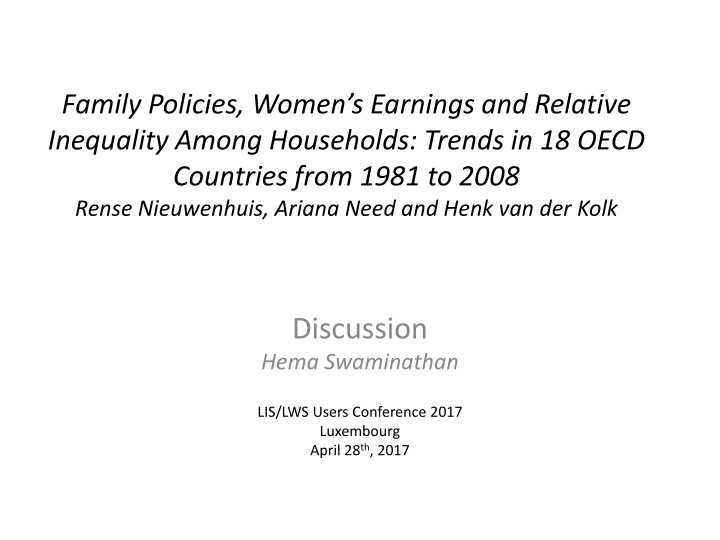
Trends in Family Policies and Women's Earnings: Insights from OECD Countries
Explore the dynamics of family policies, women's earnings, and inequality trends in 18 OECD countries from 1981 to 2008. Gain fresh insights into the causes and consequences of female labor force participation dynamics, and the interplay between family policies and earnings inequality. Discover key contributions to understanding inequality and the mechanisms driving it.
Download Presentation

Please find below an Image/Link to download the presentation.
The content on the website is provided AS IS for your information and personal use only. It may not be sold, licensed, or shared on other websites without obtaining consent from the author. If you encounter any issues during the download, it is possible that the publisher has removed the file from their server.
You are allowed to download the files provided on this website for personal or commercial use, subject to the condition that they are used lawfully. All files are the property of their respective owners.
The content on the website is provided AS IS for your information and personal use only. It may not be sold, licensed, or shared on other websites without obtaining consent from the author.
E N D
Presentation Transcript
Family Policies, Womens Earnings and Relative Inequality Among Households: Trends in 18 OECD Countries from 1981 to 2008 Rense Nieuwenhuis, Ariana Need and Henk van der Kolk Discussion Hema Swaminathan LIS/LWS Users Conference 2017 Luxembourg April 28th, 2017
Key contributions Inequality: topical, important and affects us all deeply Highlighting the role of institutions with respect to inequality via labour market integration of women Multiple pathways linking family policies and earnings inequality Fresh insights into causes and consequences of FLFPR dynamics Why do we care about women s LFP?
Discussion Suggest thinking of these as two different models to unpack the underlying mechanisms Policy & FLFPR linkages ln(FLFPR)it=b0+b1ln(reconciliationpolicies)it +b2ln(financial support policies)it+uit Inequality and the three driving mechanisms ln(Gini)it=b0+b1ln(GiniWomen)it+b2ln(Women'sshare)it+ b3ln(CorrSpouse'searnings)it+uit A log-log model, for example, will help shed light on relative elasticities
Discussion Theoretical motivation from classical FLFPR literature; how does this relate to Claudia Goldin s work on U shape relationship between economic growth and FLFP? Grand gender convergence: removing the non-linear relationship of earnings with hours worked Is there a non-monotonic relationship between family policies and FLFPR? Policies to increase female labour force participation Importance of reducing the gender wage gap Full time work vs. part time work Labour markets exhibit horizontal segregation and vertical segregation
Discussion WORLD Policy Analysis Center database can help extend this analysis beyond OECD countries https://www.worldpolicycenter.org/
